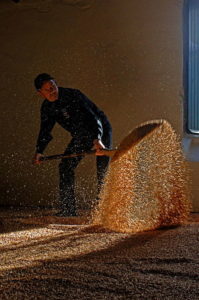
The Jewish people were very good at terracing their land with stone walls to mitigate against erosion. They used manure to enrich the soil and had developed a fairly good system of irrigation using networks of canals. Spades or hoes were used to break up smaller parcels of land; larger parcels were plowed behind oxen or a donkey. Plowing normally took place in October, but some crops required a March plowing.
Grain was usually harvested in April. Grapes were grown both at the family level and in large commercial vineyards complete with watchtowers and hedges. The vines largely took care of themselves; pruning as we know it today was not done. The real work in the vineyard took place at harvest (vintage) time. In larger vineyards people camped within the vineyard. Gatherers with little knives cut the bunches and others behind them placed them in baskets. A small amount of the harvest was set aside to be eaten, but most of the grapes were brought to be turned into wine. Most towns and villages had a winepress.
There were also figs and other fruits to be gathered. Twice a year, olive trees had to be struck with long poles. Some olives were taken to be eaten, but many more were taken to the olive press to be used for making olive oil.
Generally, the lives of Galilean farmers were reasonably happy, alternating between periods of hard and intense work at planting and reaping time, and more restful times in between. Most lived simply, close to the land, and were content if their basic necessities were met.
Shepherds – At the time of Jesus, most areas of non-arable lands were set aside for shepherding. Although these areas were dry, grasses grew in abundance. This meant that shepherds lived out on the land a great deal, in outlying areas. As a result, they had little schooling and lacked the refinements of those living in towns or villages. Although they provided a valuable service for the community, they were often looked down upon. The life of a shepherd was a hard one. Although some flocks were small, numerous shepherds cared for as many as a thousand sheep—and this is no small task. Sheep are valuable but wayward animals; they require constant vigilance. They could easily wander off and be killed by a wolf or jackal. Shepherds often had to fight directly with these predators. In the main part of the year, the fields were hot during the daytime and quite chilly at night.
In order to be able to get some sleep while out in the fields, shepherds would often corral their sheep together in sheepfolds or fenced off areas to prevent them from wandering off. In the morning, each shepherd would call to his sheep with a high piercing sound, which the sheep would recognize as the voice of their individual shepherd. The sheep would only follow this one shepherd and thus they sorted themselves out. For shepherds, family life was a rather seasonal thing; they were close to home only during the cool winter months.
In addition to tending the sheep in the field and battling off predators, shepherds also had to take care of sick sheep, pregnant sheep, and newborn lambs. It was a hard life that came with very little social standing.
Fieldworkers – Given the steep terrain in many areas, ancient Jews were very good at terracing their land. In addition, the soil was rocky and always in need of being cleared of stones. The land also needed plowing, seeds needed to be sown, and the harvest needed to be brought in. After the harvest, grains needed threshing and grapes and olives needed to be brought to the presses. Field animals also needed tending and their manure collected for fertilizer. Some workers also assisted with irrigation by digging ditches to help divert water to the fields.
Many among the Jewish peasantry filled these sorts of roles, assisting farmers and landowners with this type of work. To some degree the work was endless. Smaller family farms were generally worked by the family unit, while larger farms required the use of these field hands. Groups of families might combine to employ fieldworkers, especially when it came to more the complex tasks.
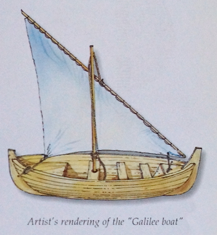 Fishermen – Fishing was not necessarily a lucrative profession, but it was considered honorable because fishermen supplied such an important part of the diet of so many people. Though some work close to shore on the Mediterranean Sea, the majority of fishermen known by Jesus and his contemporaries worked the Sea of Galilee, which is actually a freshwater lake. The many towns and villages surrounding the Sea of Galilee made fishing a huge industry. The memorable names of two of the towns were Bethsaida (the fishery) and Magdala (the fish tower or the dried fish).
Fishermen – Fishing was not necessarily a lucrative profession, but it was considered honorable because fishermen supplied such an important part of the diet of so many people. Though some work close to shore on the Mediterranean Sea, the majority of fishermen known by Jesus and his contemporaries worked the Sea of Galilee, which is actually a freshwater lake. The many towns and villages surrounding the Sea of Galilee made fishing a huge industry. The memorable names of two of the towns were Bethsaida (the fishery) and Magdala (the fish tower or the dried fish).
Commercial fishing at the time was largely done with nets. There was the “throw net,” a net of about twelve feet across fitted with weights and buoys. It was thrown over a school of fish and then the pulled in. Then there was the “dragnet,” which as the name implies was dragged behind the boat. Another form of dragnet was one anchored on one end at the shore with ropes, while the other end was attached to the boat, which sailed out and made a semi-circular path back to shore. The dragnet was then pulled ashore and emptied. Nets were expensive and required a lot of maintenance.
Once the fish were caught, they had to be sorted, because different kinds varied in worth. Further, some types of fish could not be eaten (e.g., catfish, eels, and lamprey) by the Jews. Most fish without scales could not be eaten and were thrown back into the water.
The fishing boats could be fairly big and wide. They need to be sturdy in order to endure the wind that is so common on the Sea of Galilee.
A fisherman’s life required courage and firmness as well as patience. Perhaps this is why Jesus chose several fishermen to be among his Apostles.
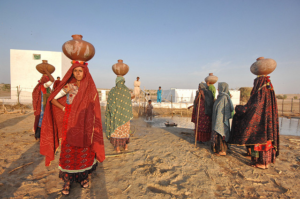
Domestic Workers – Women filled these ranks as wives, daughters, and caretakers. Women ground their own grain. Nearly every day, each housewife spent time turning the upper millstone on the lower, which was fixed to the ground. The sound of the millstone was a common one in Jewish homes. Scripture warned that when the sound of the millstone was no longer heard it signaled doom. Jeremiah speaks of it: Moreover, says the Lord, I will banish from [sinful Israel] the voice of mirth and the voice of gladness, the voice of the bridegroom and the voice of the bride, the grinding of the millstones and the light of the lamp (Jer 25:10). The Book of Ecclesiastes speaks of it in reference to the deafness of old age: The years draw nigh, when you will say, “I have no pleasure in them”; before the sun and the light and the moon and the stars are darkened and the clouds return after the rain; in the day when the keepers of the house tremble, and the strong men are bent, and the grinders cease because they are few, and those that look through the windows are dimmed, and the doors on the street are shut; when the sound of the grinding is low, and all the daughters of song are brought low (Eccl 12:2-5).
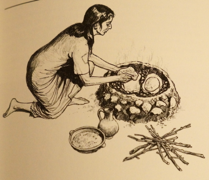 Once the grain was ground, the dough needed to be prepared and then kneaded and allowed to rise. Then the dough was cooked at home in a small oven or over a fire pit. In some smaller villages there was a communal oven.
Once the grain was ground, the dough needed to be prepared and then kneaded and allowed to rise. Then the dough was cooked at home in a small oven or over a fire pit. In some smaller villages there was a communal oven.
To a large extent, clothing was homemade as well. Proverbs 32 speaks of the excellent wife who is busy with wool and thread, holding the distaff and the spindle.
Housewives also pressed the oil from olives, made cheese, salted the meat, and made other preserves.
Scribes – In most towns and in reasonably large villages, there was also a scribe. Almost no one in those days could write and only a few could read. The few documents that were required had to be drawn up by a scribe. Letters and formal requests had to be prepared by them as well. Paper as we know it today was quite rare; parchment and lambskin were more common. It is clear that St. Paul and likely the other Gospel writers would have had to dictate their words rather than handwriting them as we might have assumed. People who needed letters or documents drawn up would dictate to a scribe, who would write out the letter, document, or request. Scribes were valued and considered highly educated. Often they were from among the religious leaders, as they were the ones most likely to be able to read and write, due to their study of Scripture. The very words “clerical” and “clergy” show the connection with this ancient task.
Service Workers – There were many people who earned their living by providing services to others. Some of these were water carriers, barbers, and hairdressers. There were also those known as fullers, who cleaned large quantities of clothing; they were somewhat similar to the dry cleaners of today. In larger towns, there were those who helped clean the streets, maintain the public baths, and repair infrastructure. Larger towns had butchers, salters of fish and meat, and bakers.
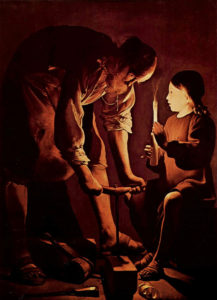 Craftsmen and Builders – Every town and village needed builders to help build and maintain homes. Chief among the builders was the stonemason. Stonemasons were common in those days because stone was abundant; wood was more rare and quite valuable in that culture. Many things that we are typically built with wood today were built with stone at that time. Along with the stonemason was the carpenter, whose work for the home included helping to build and maintain the roof, and making the doors, lintels, shelves, tables, and cabinets. Only the rich could afford paneled rooms and woodwork, which were considered opulent. For use outside the home, carpenters made ladders, wheels, yokes for the animals, and farm implements (or at least the handles).
Craftsmen and Builders – Every town and village needed builders to help build and maintain homes. Chief among the builders was the stonemason. Stonemasons were common in those days because stone was abundant; wood was more rare and quite valuable in that culture. Many things that we are typically built with wood today were built with stone at that time. Along with the stonemason was the carpenter, whose work for the home included helping to build and maintain the roof, and making the doors, lintels, shelves, tables, and cabinets. Only the rich could afford paneled rooms and woodwork, which were considered opulent. For use outside the home, carpenters made ladders, wheels, yokes for the animals, and farm implements (or at least the handles).
While some lumber might have been available locally from suppliers, most carpenters went to the woods themselves to choose the type of wood that would suit the work they were doing. Isaiah the prophet describes this work: The carpenter stretches a line, he marks it out with a pencil; he fashions it with planes, and marks it with a compass; he shapes it … He cuts down cedars; or he chooses a holm tree or an oak and lets it grow strong among the trees of the forest; he plants a cedar and the rain nourishes it (Isaiah 44:13-15).
More remote, but no less necessary, were those who worked as stonecutters and who labored in the quarries. There were also those who dug for and provided clay for the potters.
There are more than two dozen other trades mentioned in Scripture, but there is not enough space here to describe them all in detail. Among the various tradesmen mentioned we find those who were tailors and those who dyed fabrics. There were tanners, blacksmiths, leather smiths, and potters. Tanners and blacksmiths tended to live on the edge of town, given the smoky, smelly quality of their work. Blacksmiths performed essential tasks such as making and repairing spades, plowshares, axes, and hammers. Leather smiths crafted a variety of products including belts, sandals, and saddles. Potters made many household items such as pitchers, bowls, and large jars for storing grain and other foods; they also made oil lamps. Finally, goldsmiths were quite esteemed in those days. They were kept busy because people—even the poor—tended to wear more jewelry than we do today.

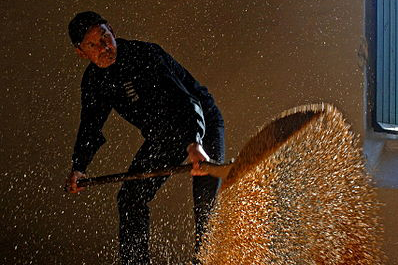
Re the scribes and their work. Most people assume that writing was done on parchment, but in fact parchment was quite expensive and ordinary letters were written on papyrus sheets. In fact, papyrus was exported even to western Europe until the collapse of the Roman Empire. Henri Pirenne pointed out that when papyrus was no longer readily available, it had a profound effect on European record-keeping until paper became widely available. In the Middle East, occasional short notes were done on bits of broken pottery. Parchment was reserved for official records and important religious works like Scripture.
Very interesting series, by the way. I am really enjoying reading it.